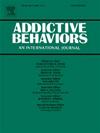环境烟草烟雾暴露的时间效应:青少年从不吸烟和实验性吸烟的生态瞬间评估研究
IF 3.6
2区 医学
Q1 PSYCHOLOGY, CLINICAL
引用次数: 0
摘要
背景:以前的横断面研究为青少年从不吸烟者和实验吸烟者的环境烟草烟雾(ETS)暴露与尼古丁依赖症状之间的关系提供了证据。本研究旨在研究尼古丁依赖样症状与ETS暴露之间的时间相关性,以及这种相关性在从不吸烟者和实验吸烟者之间是否存在差异。方法收集荷兰青少年不吸烟者(n = 105;法师= 14.48;30.5%男性)和实验性吸烟者(n = 72;法师= 16.57;30.6%的男性)。参与者自我评估依赖相关症状(愉快、不愉快、自主吸烟、头晕、欲望、戒断相关症状)和ETS暴露,每天三次,持续三周。应用二项广义线性混合效应模型检验1)同一时间段内ETS暴露与症状之间的关联,2)ETS暴露是否先于症状,以及3)反之亦然。结果分析显示,不吸烟者暴露于ETS期间,不愉快症状与ETS暴露呈正相关。实验吸烟者在同一时间间隔内对吸烟的自主性较低,在接触ETS后不久就不那么想要吸烟,在接触ETS之前的时间间隔内不那么愉快。我们没有发现ETS暴露先于依赖性症状。结论:不吸烟者和实验吸烟者暴露于ETS的门户效应存在差异。ETS暴露对从不吸烟者有潜在的不良影响,而在实验性吸烟者中可能会导致尼古丁依赖。未来的研究应增加瞬时评估的频率,以更详细地调查这些过程。本文章由计算机程序翻译,如有差异,请以英文原文为准。
Temporal effects of environmental tobacco smoke exposure: An ecological momentary assessment study among adolescent never- and experimental smokers
Background
Previous cross-sectional research provided evidence for a relationship between environmental tobacco smoke (ETS) exposure and symptoms indicative of nicotine dependence in adolescent never- and experimental smokers. This study aims to examine temporal associations between nicotine dependence-like symptoms and ETS exposure, and whether this differs between never- and experimental smokers.
Methods
Ecological momentary assessment data were collected in a sample of Dutch adolescent never-smokers (n = 105; Mage = 14.48; 30.5% male) and experimental smokers (n = 72; Mage = 16.57; 30.6% male). Participants self-rated dependence-related symptoms (pleasant, unpleasant, autonomy over smoking, dizziness, wanting, withdrawal-related symptoms) and ETS exposure three times a day for three weeks. Binomial generalized linear mixed effects models were applied examining 1) the association between ETS exposure and symptoms within the same interval, 2) whether ETS exposure precedes symptoms, and 3) vice versa.
Results
Analyses revealed a positive association between unpleasant symptoms and ETS exposure during ETS exposure for never-smokers. The experimental smokers experienced less autonomy over smoking within the same time interval, less wanting shortly after ETS exposure and fewer pleasant symptoms in the interval preceding ETS exposure. We did not find that ETS exposure precedes dependence-like symptoms.
Conclusions
Temporal effects of ETS exposure differ between never- and experimental smokers. ETS exposure has a potentially aversive effect in never-smokers, while in experimental smokers may potentially contribute to developing nicotine dependence. Future research should increase the frequency of momentary assessments to investigate the processes in more detail.
求助全文
通过发布文献求助,成功后即可免费获取论文全文。
去求助
来源期刊

Addictive behaviors
医学-药物滥用
CiteScore
8.40
自引率
4.50%
发文量
283
审稿时长
46 days
期刊介绍:
Addictive Behaviors is an international peer-reviewed journal publishing high quality human research on addictive behaviors and disorders since 1975. The journal accepts submissions of full-length papers and short communications on substance-related addictions such as the abuse of alcohol, drugs and nicotine, and behavioral addictions involving gambling and technology. We primarily publish behavioral and psychosocial research but our articles span the fields of psychology, sociology, psychiatry, epidemiology, social policy, medicine, pharmacology and neuroscience. While theoretical orientations are diverse, the emphasis of the journal is primarily empirical. That is, sound experimental design combined with valid, reliable assessment and evaluation procedures are a requisite for acceptance. However, innovative and empirically oriented case studies that might encourage new lines of inquiry are accepted as well. Studies that clearly contribute to current knowledge of etiology, prevention, social policy or treatment are given priority. Scholarly commentaries on topical issues, systematic reviews, and mini reviews are encouraged. We especially welcome multimedia papers that incorporate video or audio components to better display methodology or findings.
Studies can also be submitted to Addictive Behaviors? companion title, the open access journal Addictive Behaviors Reports, which has a particular interest in ''non-traditional'', innovative and empirically-oriented research such as negative/null data papers, replication studies, case reports on novel treatments, and cross-cultural research.
 求助内容:
求助内容: 应助结果提醒方式:
应助结果提醒方式:


